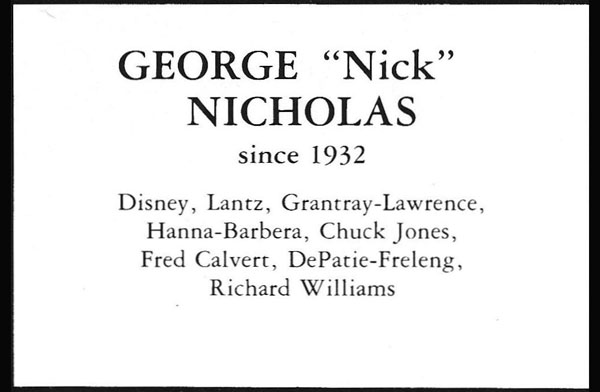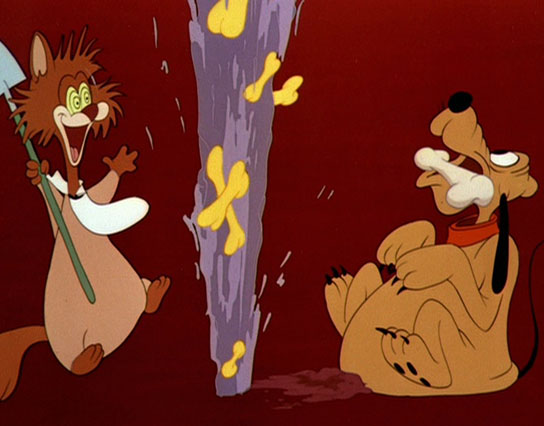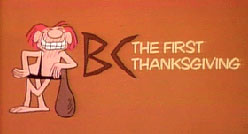
George H. “Nick” Nicholas was an animator with a considerable reputation both in the industry and among aficionados whose memory has been ensconced by a scholarship at Pennsylvania’s Edinboro University. Born in Vermilion, Ohio, he moved with his family to Los Angeles when he was 10. He showed an early interest in art, but first found work during the Depression in construction before becoming an inbetweener at Walter Lantz in 1932; Nicholas then moved over to Disney’s as an assistant. He switched back to Lantz before, as he told Dan McLaughlin in his video interview from the 1986 Golden Awards Banquet, “some fellows talked me [into going] over to Disney’s.”

A scene from “Plutopia” (1951) animated by George Nicholas
There, under the tutelage of Charles “Nick” Nichols, he became an animator, initially on Pluto and Goofy shorts, before eventually working on such features as Lady and the Tramp, Sleeping Beauty and 101 Dalmatians. At the time of the 1941 Disney strike, which Nicholas participated in, it was noted he was making $52.25 a week. His career at Disney ended when he got caught up in the layoffs that marked the end of the production of theatrical shorts and Sleeping Beauty.
After working on some TV commercials, it was suggested Nicholas go to Hanna-Barbera, which was just starting up. He recalled that he “worked on a lot of their films, Huckleberry Hound and all of them. They were very nice to work for and they got into doing half hour ones, so I got into fuller animation, and it was very nice too.” His credits there also included Loopy de Loop, The Flintstones and The Jetsons. Despite the constraints of limited animation, his work would win praise from the likes of latter-day animators John Kricfalusi and Mark Kausler; for instance, the latter was quoted as noting, “Nicholas has the richest, fullest looking dialogue animation on the early Flintstones shows. Instead of using just a straight up and down ‘head bob’ formula, he varies it by shaking the head ‘yes’ and ‘no’ to the mood of the dialogue accompanied by a shrugging gesture. He also uses a special sarcastic head rotation in perspective for some lines. He uses a unique ‘beady eyed’ expression on his characters, drawing tiny pupils in Fred’s eyes when he’s getting an idea or when he’s hypnotized by something. He draws big, fat fingers on Fred’s hands, especially in pointing gestures, like in the Frog Mouth episode.”
Nicholas nevertheless seemed to bridle at the constraints of early TV animation and jumped at the chance to work with Chuck Jones, because he “was doing [TV] films that were closer to Disney-type animation…. So, I went and started working with Chuck and we did some very nice half hour films, as full as we could get them,” including Rikki-Tikki-Tavi and The White Seal; though he said they were “not quite up to Disney’s [standards, they were] comparable.” He also worked with Jones on a series of educational film combining animation and live action.
 He and Hal Ambro went to England to work on Richard Williams’ Oscar-winning short, A Christmas Carol. “It was a very different type of film that Dick was interested [in]; we worked right on cels in sketching, very sketchy, and a very nice film.” Nicholas also fondly remembers working on several other TV specials, including two based on Johnny Hart comic strips— B.C.: The First Thanksgiving and The Wizard of Id—and one featuring the Berenstain Bears (probably The Berenstain Bears’ Christmas Tree).
He and Hal Ambro went to England to work on Richard Williams’ Oscar-winning short, A Christmas Carol. “It was a very different type of film that Dick was interested [in]; we worked right on cels in sketching, very sketchy, and a very nice film.” Nicholas also fondly remembers working on several other TV specials, including two based on Johnny Hart comic strips— B.C.: The First Thanksgiving and The Wizard of Id—and one featuring the Berenstain Bears (probably The Berenstain Bears’ Christmas Tree).
He retired circa 1979, devoting more time to his passion for painting and wood sculpture. In 1991, he moved to Eire, Pennsylvania to be with his daughter, the painter Donna Nicholas, who was teaching at Edinboro University. After he died in 1996, she inherited his collection of animation art, which included his own work and that of others. She packaged 159 of these items into a touring exhibition, “From Mickey to the Grinch: Art of the Animated Film,” which went on a nationwide tour of regional art museums. The collection was then sold and the proceeds used to fund the George Nicholas Memorial Scholarship in animation at Edinboro.
For more on Nicholas, there is his self-published An Autobiography and Animation Scrapbook (1976), copies which can occasionally be found. More accessible is a posting on John Simcoe’s Comics on the Brain, which nominally tells the backstory of the traveling exhibit, but also includes biographical information and comments by his daughter. Mike Kazaleh briefly spotlights several commercials Nichols animated on this site, while Don Yowp reprints a fuller version of his obituary from the Los Angeles Times on his Yowp blog than is found on the Times’ website.
Next week: Hal Ambro and Lee Blair.


 Harvey Deneroff is an independent film and animation historian based in Los Angeles specializing in labor history. The founder and past president of the Society for Animation Studies, he was also the first editor of Animation Magazine and AWN.com. Harvey also blogs at deneroff.com/blog.
Harvey Deneroff is an independent film and animation historian based in Los Angeles specializing in labor history. The founder and past president of the Society for Animation Studies, he was also the first editor of Animation Magazine and AWN.com. Harvey also blogs at deneroff.com/blog.




































































Joe Ruby (later better known as the Ruby in Ruby-Spears Enterprises) was film editor on “Two-Faced Wolf,” the Loopy de Loop short.
“Two-Faced Wolf” is also noteworthy for being briefly excerpted in the Monkees’ feature film, Head.
I’d like to know more about that Wizard of Id special. (I’ve seen the B.C. Thanksgiving special but not its Chirstmas counterpart.)
Also, those Chuck Jones educational films sound interesting…
I wrote about that Wizard of Id film a while ago – https://cartoonresearch.com/index.php/the-wizard-of-id-1970/
Nick Nicholas working for Nick Nichols – It must have been confusing at the animation studio for a while.
Thanks for posting this, Harvey. George Nicholas remains one of my favorite animators. I met him when he used to work at Fred Calvert’s studio in North Hollywood, he was always very nattily dressed, as he is in the video. He was not too talkative, at least to an eager young space cadet like me. It wasn’t until much later that I began to recognize the hallmarks of his drawing and timing, as you’ve outlined in your text. I think when he talks about the Chuck Jones educationals, that he is referring to “Curiosity Shop”, the short-lived Saturday morning series that Chuck produced from 1971 to ’73. This series had a lot of short bits, some of which were comic strip characters and book characters like the Barenstain Bears. There aren’t a lot of Curiosity Shop episodes around today, but a lot of the segments exist. Again, thanks for making it possible to hear and see one of the truly great comic animators of all time!
Hello, does anyone have an example of George Nicholas’s signature? I bought a wonderful midcentury-looking watercolor at a thrift store in Los Angeles that’s signed George Nicholas and I’m wondering if it was done by this George Nicholas.